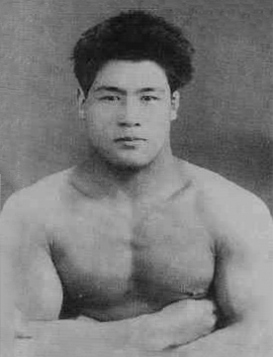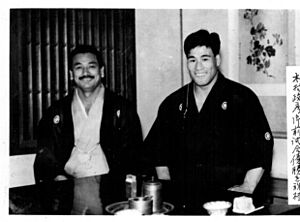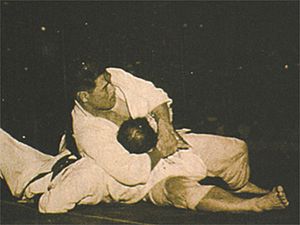Masahiko Kimura facts for kids
Quick facts for kids Masahiko Kimura |
|
|---|---|
 |
|
| Born | September 10, 1917 Kumamoto, Empire of Japan |
| Died | April 18, 1993 (aged 75) Tokyo, Japan |
| Nationality | Japanese |
| Height | 170 cm (5 ft 7 in) |
| Weight | 84 kg (185 lb) |
| Style | Judo |
| Rank | 7th dan Judo and Karate |
| Occupation | Judoka and professional wrestler |
| University | Takushoku University |
Masahiko Kimura (木村 政彦, Kimura Masahiko, September 10, 1917 – April 18, 1993) was a famous Japanese judoka and professional wrestler. Many people consider him one of the greatest judo fighters of all time. He won the All-Japan Judo Championships three times in a row. This was a first in history. He also never lost a judo match from 1936 to 1950.
One author said that no one was stronger than Kimura in judo history. He is often called the strongest judoka ever. In submission grappling, a special arm lock is named the "Kimura." This is because of his famous win over Gracie jiu-jitsu founder Hélio Gracie. In Japanese professional wrestling, he is known for a match he had with Rikidōzan.
Contents
Kimura's Early Life and Judo Training
Masahiko Kimura was born on September 10, 1917, in Kumamoto, Japan. He started training in Judo when he was 9 years old. After six years, at age 15, he earned his yondan (4th degree black belt). He had defeated six opponents in a row, all of whom were 3rd or 4th dan.
In 1935, at 18, he became the youngest ever godan (5th degree black belt). He achieved this by defeating eight opponents in a row at Kodokan. The Kodokan is the main headquarters for Judo.
Kimura's Intense Training Methods
Kimura's amazing success came from his very strict training. His teacher, Tatsukuma Ushijima, guided him. Kimura reportedly lost only four judo matches in his life. All these losses happened in 1935. He thought about quitting judo then. But his friends encouraged him to keep going.
He practiced a leg throw called osoto gari (large outer reap) against a tree every day. His daily sparring sessions, called randori, were very tough. Many opponents got concussions or passed out. Some even asked Kimura not to use his osoto gari on them.
At the peak of his career, Kimura trained for nine hours daily. This included a thousand push-ups. He earned his 7th dan black belt at age 30. This rank was later put on hold due to disagreements with the Kodokan.
Kimura's Karate Training
Kimura also trained in Karate to improve his martial arts skills. He believed karate would make his hands stronger. He first learned Shotokan Karate from its founder, Gichin Funakoshi, for two years. Later, he switched to Goju-Ryu Karate. He trained under So-Nei Chu, a student of Goju-Ryu founder Chōjun Miyagi.
Kimura became an assistant instructor. His friends Gogen Yamaguchi and Masutatsu Oyama also trained with him. Oyama was also his university classmate. Kimura wrote in his book that using the makiwara (a karate training tool) helped him a lot. He started using the makiwara daily before his first All Japan success. After that, he never lost another competition.
Kimura's Famous Match Against Hélio Gracie
In 1949, Kimura and his team traveled to Brazil. They were invited by a Japanese newspaper. There, they were challenged by Hélio Gracie from Gracie Jiu Jitsu. Gracie suggested a match under "Gracie Rules." These rules meant that throws and pins would not count for a win. Only a submission (making someone give up) or loss of consciousness would count. This was different from judo rules, but Kimura's team accepted.
Kimura's teammate, Yukio Kato, fought Hélio Gracie first. They drew in their first match. But Kato lost the rematch. Kimura then volunteered to fight Hélio Gracie himself.
The Historic Fight in Brazil
The match between Gracie and Kimura happened at the Maracana stadium. About 20,000 people watched, including the president of Brazil. The Japanese embassy warned Kimura that he must not lose. Brazilian fans threw eggs and insulted Kimura. The Gracie team even brought a coffin to symbolize Kimura's defeat.
At the start, Hélio tried to throw Kimura. But Kimura blocked him and threw Gracie many times. He used moves like ouchi gari, harai goshi, uchi mata, and ippon seoi nage. However, Hélio Gracie was able to land safely because of the soft mat. So, Kimura could not win by throwing alone.
In the second round, Kimura took the fight to the ground. He pinned Gracie with kuzure-kami-shiho-gatame. Kimura held Gracie in several positions, like kesa-gatame. Gracie looked like he couldn't breathe, but he kept fighting. When Gracie tried to move his arm, Kimura grabbed it. He then used a move called gyaku-ude-garami. Hélio did not give up, so Kimura twisted his arm until it broke. Gracie still refused to surrender. Kimura twisted the arm again, breaking it a second time. Finally, Gracie's corner threw in the towel, and Kimura won.
Japanese fans celebrated Kimura's victory. Doctors treated Hélio's arm. As a tribute to Kimura's win, the armlock he used is now called the Kimura lock or simply the Kimura. This name is used in Brazilian Jiu-Jitsu and mixed martial arts.
Kimura's Professional Wrestling Career
In the early 1950s, Kimura started his own wrestling group. He was also invited by Rikidōzan to become a professional wrestler. They sometimes worked as a team and sometimes fought each other. However, Rikidōzan was more famous than Kimura.
The Controversial Match with Rikidōzan
Kimura and Rikidōzan had a big match for the Japanese Professional Wrestling Heavyweight title. This match did not go as planned. Kimura said that Rikidōzan did not follow the script. Rikidōzan hit Kimura for real during the match. Kimura said he was knocked out. Rikidōzan won the match by knockout. Kimura never got a rematch.
Kimura later formed another wrestling group called International Pro Wrestling Force (IPWF). This group was based in his hometown. It was known for bringing Mexican Lucha Libre wrestlers to Japan for the first time.
Some people believe Kimura started professional wrestling to pay for his wife's medicine. She had tuberculosis. Being a police instructor, his previous job, might not have paid enough for her treatment.
Kimura's Last Fight in Brazil
Kimura returned to Brazil in 1959 for his last professional wrestling tour. He was challenged by Valdemar Santana to a "real" (not fake) submission match. Santana was a champion in Brazilian jiu-jitsu and capoeira. He was younger and heavier than Kimura. Santana had also defeated Hélio Gracie in a very long fight.
Kimura showed his training to the press. He let partners try to choke him, and he just smiled. This showed he was not afraid. They agreed to two matches. The first was a grappling match. The second was a vale tudo (anything goes) match ten days later.
The Two Matches with Santana
The first match happened on July 1. It was fought in judogis (judo uniforms). Santana mostly played defense. Kimura threw Santana with moves like seoi nage and osoto gari. He then applied his famous gyaku-ude-garami armlock. Newspapers said Kimura won easily.
The second match on July 12 was more exciting. Santana was experienced in vale tudo, but Kimura was not. Kimura was also not feeling well due to illness. The two fighters started by punching and kicking. Santana showed he was better at striking. Kimura took Santana to the ground and hit him with elbow strikes. Santana escaped, but Kimura broke his nose with a punch. Both fighters were tired and bleeding. They continued to exchange strikes until the match ended.
Death
Masahiko Kimura died on April 18, 1993. He was 75 years old. He had been battling lung cancer for a long time.
Achievements
- All-Japan Collegiate Championships (1935)
- 7th All Japan Judo Championship (1937)
- 8th All Japan Judo Championship (1938)
- 9th All Japan Judo Championship (1939)
- Ten-Ran Shiai tournament (1940)
- 1947 West Japan Judo Championship
- 1949 All Japan Judo Championship
- 1936 Takudai Kosen Judo Championship
See also
 In Spanish: Masahiko Kimura para niños
In Spanish: Masahiko Kimura para niños
- Takushoku University
- Armlock
- Shoulderlock



